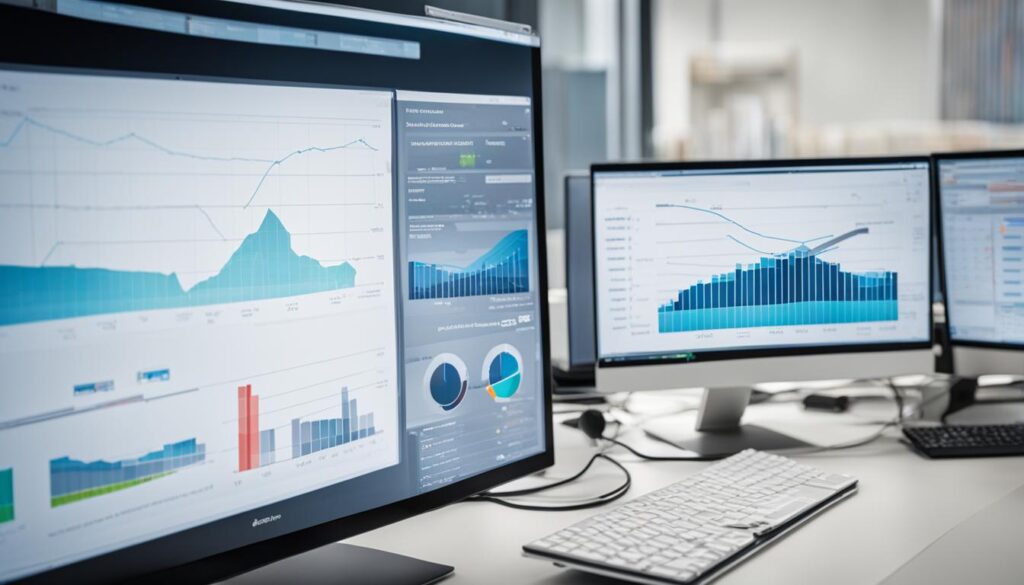Telemetry is a powerful technology that plays a vital role in various industries, including information technology. It involves the automatic measurement and wireless transmission of data from remote sources, enabling real-time monitoring and analysis. Telemetry systems are widely used in software development, meteorology, agriculture, space exploration, defense, and healthcare.
In software development, telemetry allows developers to remotely monitor the health, security, and performance of applications. It provides valuable insights into metrics such as startup times, crashes, user behavior, and resource usage. Telemetry also finds applications in fields like meteorology, agriculture, and healthcare, contributing to better data collection and monitoring.
Telemetry systems utilize wireless sensor networks, telecommunication technology, and data transmission technology for efficient data transmission. It enables digital communications and remote monitoring technology, empowering decision-makers with crucial insights.
However, telemetry does come with its own set of challenges. Issues such as data access limitations, the influx of data from IoT devices, and compatibility problems with legacy systems can pose obstacles. Nevertheless, telemetry remains a game-changer in information technology, revolutionizing data collection and monitoring.
Contents
- 1 What is Telemetry and How Does it Work?
- 2 Applications of Telemetry in Various Fields
- 3 Challenges of Telemetry in Software Development
- 4 Conclusion
- 5 FAQ
- 5.1 What is telemetry?
- 5.2 How does telemetry work?
- 5.3 Where is telemetry used?
- 5.4 What are the types of telemetry monitoring in software development?
- 5.5 What are the benefits of telemetry in software development?
- 5.6 What are the challenges of telemetry in software development?
- 5.7 What is the role of telemetry in information technology?
- 6 Source Links
Key Takeaways:
- Telemetry is the automatic measurement and wireless transmission of data from remote sources.
- It is used in various industries, including software development, meteorology, agriculture, space exploration, defense, and healthcare.
- Telemetry enables real-time monitoring and analysis of applications, providing insights into performance, crashes, user behavior, and resource usage.
- It utilizes wireless sensor networks, telecommunication technology, and data transmission technology for data transmission.
- Telemetry presents challenges such as data access limitations, data deluge from IoT devices, and compatibility issues with legacy systems.
What is Telemetry and How Does it Work?
Telemetry is the automatic recording and wireless transmission of data from remote sources. It involves using sensors to measure either electrical data (such as voltage and current) or physical data (such as temperature and pressure) at the source. This data is then converted into electrical voltages and combined with timing data to form a data stream. The data stream is transmitted through a wireless medium or wired connection to a remote receiver, where it is disaggregated and displayed or processed based on user specifications.
Telemetry enables remote monitoring and analysis of data, providing insights into the health, performance, and security of systems or applications. It is used in various fields and industries, including software development, meteorology, agriculture, space exploration, defense, and healthcare.
Applications of Telemetry in Various Fields
Telemetry is a versatile technology that finds applications in diverse fields, catering to the unique needs and requirements of each industry. Let’s explore how telemetry is utilized in the following sectors:
1. Software Development
In software development, telemetry plays a crucial role in monitoring the performance and health of applications. It enables developers to collect real-time data on metrics such as startup times, crashes, user behavior, and resource usage. By analyzing this data, developers can identify bottlenecks, optimize performance, and enhance the overall user experience.
2. Meteorology
Telemetry is extensively used in meteorology for data collection and transmission from weather stations and sensors. It enables meteorologists to gather crucial information about temperature, humidity, wind speed, and atmospheric pressure. This data is essential for accurate weather forecasting and monitoring climatic patterns.
3. Agriculture
In the field of agriculture, telemetry assists in monitoring and controlling environmental conditions in greenhouses and agricultural fields. By utilizing telemetry systems, farmers can collect data on factors such as soil moisture, temperature, and sunlight intensity, enabling them to optimize irrigation, manage crop growth, and maximize yields.
4. Space Exploration
Telemetry plays a vital role in space exploration, allowing scientists and engineers to monitor spacecraft and collect valuable data. It facilitates the remote control and monitoring of spacecraft systems, including power consumption, temperature, pressure levels, and various other critical parameters necessary for successful space missions.
5. Defense
In the defense sector, telemetry is utilized to monitor the performance of advanced military equipment, including missiles, aircraft, and vehicles. It enables real-time tracking of vital parameters such as speed, altitude, temperature, and vibration levels, ensuring optimal performance and safety during military operations.
6. Healthcare
Telemetry technology is also applied in healthcare for remote patient monitoring and data collection. It allows medical professionals to track vital signs, such as heart rate, blood pressure, and oxygen levels, from a remote location. This enables proactive healthcare management, early detection of potential issues, and improved patient outcomes.
These are just a few examples of the myriad applications of telemetry across various industries. Whether it’s in software development, meteorology, agriculture, space exploration, defense, or healthcare, telemetry empowers end users to collect critical data from remote locations, enabling accurate monitoring and analysis.

| Benefit | Description |
|---|---|
| Remote Feedback | Real-time monitoring and remote feedback for faster issue resolution |
| Performance Monitoring | Real-time insights into application performance for optimized user experience |
| Activity Monitoring | Tracking user behavior and interactions for analysis and optimization |
| Enhanced Security | Identifying and addressing security risks through system monitoring |
| Real-Time Insights | Continuous improvement based on real-time data and user feedback |
Telemetry is an invaluable tool in software development, providing developers with the necessary insights to create robust, performant, and secure applications. By harnessing the power of telemetry, developers can continuously enhance their software, driving better user experiences and delivering exceptional value to end-users.
Challenges of Telemetry in Software Development
While telemetry offers numerous benefits, it also presents certain challenges in the field of software development. These challenges can affect various aspects of the development process, including data access, managing the data deluge, addressing legacy issues, ensuring user privacy, and effectively gathering and utilizing data.
Data Access
One of the challenges faced in telemetry-based software development is accessing the necessary data. Depending on the nature of the system, collecting relevant data may require integration with multiple sources, such as servers, networks, applications, or cloud services. Ensuring seamless and efficient data access can be complex, especially when dealing with diverse technologies and platforms.
Data Deluge
The increasing popularity of the Internet of Things (IoT) has resulted in a massive influx of data from numerous interconnected devices. This data deluge can overwhelm software developers, making it challenging to filter and extract meaningful information from the vast amount of telemetry data. Effectively managing and analyzing this data becomes crucial for obtaining actionable insights.
Legacy Issues
Incorporating telemetry into existing software systems often poses challenges due to legacy issues. Legacy systems may lack the necessary infrastructure or compatibility with modern telemetry technologies. Developers must find ways to integrate telemetry into legacy applications and devices to ensure they can benefit from its capabilities without disrupting the existing functionality.
User Privacy
Telemetry involves gathering data from users to monitor and improve software performance. However, ensuring user privacy and data protection while collecting telemetry data is crucial in maintaining user trust. Striking the right balance between gathering valuable insights and respecting user privacy presents a significant challenge for software developers.
Data Gathering
The effectiveness of telemetry in software development heavily relies on the data gathered. Ensuring the collection of relevant and accurate data is essential for making informed decisions and improving applications. However, identifying the appropriate metrics to collect and optimizing data gathering processes can be challenging, requiring careful planning and consideration.
To overcome these challenges, software developers need to adopt robust strategies that address data access limitations, handle the data deluge effectively, tackle legacy issues, prioritize user privacy, and implement efficient data gathering techniques. By doing so, they can harness the power of telemetry to drive innovation and enhance software development processes.
“Effective telemetry implementation requires addressing various challenges, from data access limitations to user privacy concerns, to unlock its full potential in software development.”
Challenges of Telemetry in Software Development
| Challenge | Description |
|---|---|
| Data Access | Ensuring seamless access to relevant data from multiple sources, such as servers, networks, and applications. |
| Data Deluge | Managing and deriving meaningful insights from vast amounts of telemetry data generated by IoT devices. |
| Legacy Issues | Integrating telemetry into existing software systems with legacy infrastructure and compatibility limitations. |
| User Privacy | Balancing the collection of valuable telemetry data with respect for user privacy and data protection. |
| Data Gathering | Identifying relevant metrics and optimizing data gathering processes to drive informed decisions and improvements. |

Conclusion
Telemetry is a fundamental aspect of information technology that revolutionizes data collection, monitoring, and analysis across various industries. In the context of software development, telemetry systems offer real-time insights into the health, performance, and security of applications, empowering developers to make informed decisions and continuously enhance their systems.
With applications spanning meteorology, agriculture, space exploration, defense, and healthcare, telemetry enables remote data collection and monitoring, enabling better decision-making processes. The benefits of telemetry in software development are manifold, including the ability to receive remote feedback, monitor performance, track user activity, and bolster security measures.
However, telemetry is not without its challenges. Data access limitations, the overwhelming amount of data generated by IoT devices, and compatibility issues with legacy systems pose obstacles in deploying and utilizing telemetry effectively. Despite these challenges, telemetry plays a pivotal role in transforming data collection and monitoring within the realm of information technology, safeguarding better decision-making processes and yielding improved outcomes.
FAQ
What is telemetry?
Telemetry is the automatic measurement and wireless transmission of data from remote sources. It involves using sensors to measure electrical or physical data, which is then transmitted to a remote location for monitoring and analysis.
How does telemetry work?
Telemetry works by using sensors to measure either electrical data or physical data at the source. This data is converted into electrical voltages and combined with timing data to form a data stream. The data stream is then transmitted through a wireless medium or wired connection to a remote receiver, where it is disaggregated and displayed or processed based on user specifications.
Where is telemetry used?
Telemetry is used in various industries, including software development, meteorology, agriculture, space exploration, defense, and healthcare, for data collection and remote monitoring purposes.
What are the types of telemetry monitoring in software development?
The key types of telemetry monitoring in software development include performance monitoring, activity monitoring, security analysis, and remote feedback.
What are the benefits of telemetry in software development?
Telemetry provides benefits such as remote feedback, performance monitoring, activity monitoring, and real-time insights into the health, performance, and security of applications and systems.
What are the challenges of telemetry in software development?
Some of the challenges associated with telemetry in software development include data access limitations, handling the data deluge from IoT devices, legacy issues with older devices and applications, and ensuring user privacy during data gathering.
What is the role of telemetry in information technology?
Telemetry plays a crucial role in transforming data collection and monitoring in information technology, facilitating better decision-making and improved outcomes in fields such as software development, meteorology, agriculture, space exploration, defense, and healthcare.




